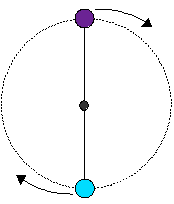All of the formulas and questions that we have been working with up to this point have depended on one characteristic… that the object is moving in a horizontal circle.
- By horizontal circle, I mean that the object spins in a circle that is parallel to the ground.
- Imagine a string with a weight tied to the end. You rest it on the floor, and then start to spin it around in a circle so that the weight is dragging along on the floor. That’s an example of a horizontal circle.
- When something is spinning in a vertical circle, we need to take into account that gravity will have different effects on the object at different times.
Tie something to the end of a string and spin it in a vertical circle.
- If you spin it too slowly, then the tension in the string disappears when it is at the top of its swing. The weight might even start to fall.
- This never happens at the bottom of the swing.
- There must be some sort of relationship between the tension in the string (a force), the centripetal force, and the force due to gravity.
- Let’s look at an example problem to see if we can work it out.

Example 1: A ball is spinning in a vertical circle at the end of a string that is 2.0m long. If the ball has a mass of 3.5kg and moves at a constant speed of 8.0m/s…
a) determine the tension in the string when the stopper is at the bottom of the circle.
b) determine the tension in the string when the stopper is at the top of the circle.
Be very careful as we start off these questions. You're temptation may be to figure out the net force acting on the ball at the end of the string. Remember, that's not what the question asked for. We are supposed to figure out the tension in the string, and although this depends on what happens with the forces acting on the ball, it is not the same thing.
Since the ball has mass, there must be a force due to gravity (Fg) acting on it downwards. This will cause some pull on the ball down. Even without spinning the ball, this force would be there.
Fg = mg = (3.5kg)(9.81m/s2) = 34N
Since the ball is moving in a circle, there must be a centripetal force (Fc) acting on the ball to keep it moving in a circle. That force always acts towards the centre of the circle, pulling the ball towards there. We can calculate this force (no sig digs for now since we'll be doing a bunch of calculations in the next few steps with these numbers).
Fc = mv2 / r = (3.5 kg) (8.0m/s)2 / 2.0m = 112N
Now we will use these numbers and a bit of reason to calculate the tension in the string at the different points.
a) Tension at the bottom...
At the bottom of the circle, the ball is being pulled down by gravity. This means that the string has to try to support this weight... the string will feel a force pulling it down.
Fg = -34N
At the same time, the ball is also being pulled up towards the centre of the circle by the centripetal force. By Newton's 3rd law, if the ball is pulled up by the string, the string will be pulled down by the ball.
Fc = -112N
So the total net force acting on the string, which is the tension in the string, is…
FT = -34N + -112 N = -146N = -1.5e2 N
This force is bigger than the weight of the ball alone, so maybe the string will snap. It is at the bottom of the swing that the string has the greatest chance of snapping if it is not strong enough.
b) Tension at the top...
What happens at the top of the circle? The same sort of thing, with a few slight changes.
At the top of the circle, gravity is still pointing down. It has to! It’s gravity!
Fg = -34N
So we would still have the same value of -34 N for the force due to gravity. The centripetal force acting on the ball still points towards the centre of the circle (like it always does), but this means that the centripetal force acting on the ball is now pointing down. By Newton's 3rd Law, this means the force acting on the string is up!
Fc = +112N
This means that the net force (the tension) acting on the string is
FT = -34N + 112 N = 78N
This tension is less than we calculated in part (a), so if the string is strong enough to swing the ball through the bottom of the swing, it will certainly be strong enough at the top of the swing. This is why the string doesn’t feel as taut (tight) at the top of the swing. There isn’t as much tension in it.
Example 2: For the same circle described above, what is the minimum speed at which you could swing the ball so that the string won’t go slack (limp) at the top of the swing?
The minimum speed would happen when the centripetal force and the force due to gravity are exactly equal at the top of the swing. This would make the tension exactly zero, and the ball would just barely be able to continue moving in a circle.
Fg = Fc
mg = mv2/r <- "m" cancel out
g = v2 / r
v = √ (gr)
= √ (9.81 x 2.0)
v = 4.4 m/s
If I told you the string can withstand up to 400 N of force, how would you calculate the maximum speed the ball could move before the string would snap?